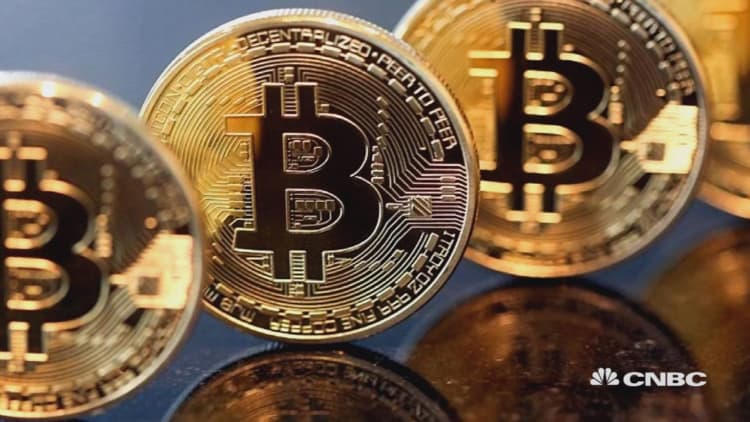
The Cboe will launch futures trading in bitcoin at 6 p.m. ET on Sunday. The ticker symbol will be XBT.
Since the interest level is so high, let's try to answer a few basic questions on how this will work.
So how does this work? The Cboe will start by listing three near-term serial months. They will likely be January, February and March. They will expire on two business days prior to the third Friday of the month.
What will the initial prices be and what is the size of a contract? Each contract is one bitcoin. Market makers will set an initial price for each month and trading will begin. The front-month (January) price will likely be close to the underlying cash price. The minimum price interval is $10.00 per contract. The contracts are traded and settled in cash (you get dollars, not bitcoin, at the settlement).
How is the price determined? There are many different bitcoin exchanges, but Cboe uses Gemini Trust Co., an exchange and custodian founded in 2014 that allows customers to buy, sell and store digital assets such as bitcoin. There is a lively debate about how to "accurately" reflect the bitcoin price. CME, for example, is using the Bitcoin Reference Rate which is an aggregate of prices on four different exchanges. Bitcoin futures at CME are set to begin trading Dec. 18.
What are the fees for trading? Cboe will be waiving all of its transaction fees for the month of December. After that, the basic retail rate is $1.00 per contract.
"What is the margin rate? Right now, the Cboe and CME will have margin rates of 44 and 35 percent, respectively. (Note: Cboe has recently raised the rate from 33 to 44 percent) For example, if bitcoin is trading at $15,000, you can purchase a contract on margin for $6,600 (44 percent of $15,000)."
When can I trade? Almost 24 hours a day during the week. Regular hours are 9:30 a.m. to 4:15 p.m. ET Monday through Friday, but extended trading hours go from 6 p.m. ET Sunday to 9:30 a.m. ET Monday, then 4:30 p.m. to 9:30 a.m. ET Tuesday through Friday.
How can I trade bitcoin futures on Cboe? You should contact your brokerage firm. Not surprisingly, retail brokers do not have a uniform stance on whether they will allow their clients to trade bitcoin futures. Fidelity is not currently planning to allow its members to trade futures contracts. Interactive Brokers will allow trading, but with a much-higher 50 percent margin requirement. Charles Schwab says it is evaluating its client interest in bitcoin, including their familiarity with the risk. And a TD Ameritrade spokesperson told CNBC they will only allow trading once volumes, open interest, and the market place meet their threshold
A number of large firms that typically cater to institutional brokers have already said they will not initially offer their clients access to the bitcoin futures market, including JPMorgan, Bank of America Merrill Lynch and Citigroup. Goldman Sachs, the largest U.S. futures broker, will offer access but only for certain customers.
If my broker doesn't allow me to trade bitcoin futures, are there any other options? You could open a separate futures account with a futures broker, such as R.J. O'Brien.
Are there any price limits or trading halts? There are no price limits, but trading can be halted for two minutes under certain circumstances, for example when prices rise or fall 10 percent from the previous day's price, and five minutes if it rises or falls 20 percent. The cash market for bitcoin would not be halted.
Will futures reduce or increase the volatility of bitcoin? No one knows. A lot will depend on how liquid the contracts themselves are, which depends on the number of participants and how many firms allow access to trading.
"Historically, the introduction of futures contracts has tended to reduce volatility in the underlying asset," Brian Kelly of Brian Kelly Capital Management told me. "But in the short term, since you may not have a lot of sellers, it could exacerbate the volatility."
Can you short the futures contract? Yes. For example, suppose the bid is $15,000, you can go in and sell it immediately (you will have to post the margin requirement of 30 percent). You are now short one bitcoin contract at $15,000. If that goes to $16,000, you will have a potential loss of $1,000, and you may be forced to put up more margin. If it goes to $14,000, you have a potential profit of $1,000. You can close out the position at any time, or if you wait until the expiration it will settle automatically to cash.
Who are the market makers? There has not been a formal announcement of who the market makers will be, but some of the known large players — such as DRW and Virtu Financial — will be participating.
Who are the sellers? This is one of the big questions. You will likely see bitcoin miners as well as hedgers, or people who own bitcoin but sell futures against that to capture the spread. You may also see institutional traders come in because it's a cash traded and settled account, you don't need bitcoin.
So is all this hoopla around futures contracts going to make bitcoin respectable? Not necessarily, but it is certainly a first step toward it. It's also the first step toward some regulation of this market, which is a welcome development.
Most importantly, it's a big step toward making this whole cryptocurrency thing a little more open.
"This is your first opportunity to take a bitcoin derivative and put it on a centrally cleared exchange that has transparency," JJ Kinahan, chief derivatives strategist at Ameritrade, told me.
Correction: The Cboe and CME margin rates will be 44 and 35 percent, respectively. An earlier version misstated the percentages.
WATCH: Everything you need to know about bitcoin



